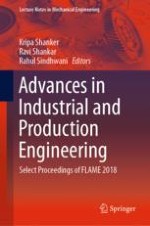This book comprises select proceedings of the International Conference on Future Learning Aspects of Mechanical Engineering (FLAME 2018). The book discusses different topics of industrial and production engineering such as sustainable manufacturing systems, computer-aided engineering, rapid prototyping, manufacturing management and automation, metrology, manufacturing process optimization, casting, welding, machining, and machine tools. The contents of this book will be useful for researchers as well as professionals.
